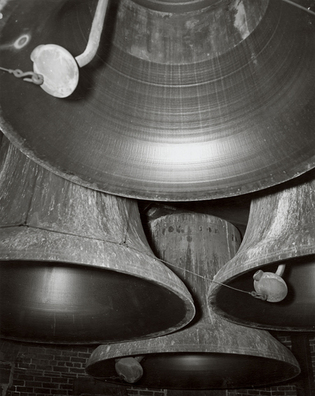 loading
loading
Old Yale"Showered with sound"When the Harkness bells met a West Point cannon.
Guest columnist Jon Butler, former dean of the Graduate School, is the Howard R. Lamar Professor of American Studies, History, and Religious Studies. Judith Ann Schiff returns next issue.
 Manuscripts & ArchivesThe ten original bells of Harkness Tower were featured along with a West Point cannon in a technologically novel 1956 record of Tchaikovsky's 1812 Festival Overture. View full image
On January 4, 1955, three engineers and producers for Mercury Records—Wilma Cozart, C. Robert Fine, and David Hall ’39—caught on audiotape the sound of a Yale student whistling as he walked across the Branford College courtyard. Cozart, Fine, and Hall were recording the Harkness bells as part of a novel project: the first recording of Tchaikovsky’s 1812 Festival Overture to include the bells and cannon fire he had wanted for the 1880 Moscow premiere, but which never happened in his lifetime. Their effort led to one of the best-selling classical disks of the 1950s—Mercury MG 50054, released in early 1956—a dramatic monaural recording that included Yale’s bells and a 1761 French cannon owned by West Point. The Mercury Record Corporation, an upstart in the recording world, was the perfect vehicle for the work. Together, Cozart, Mercury’s classical music producer; Fine, a contractor widely regarded as one of the greatest late-twentieth-century recording engineers; and Hall, Mercury’s music director, created the “Living Presence” classical recordings, whose unprecedented frequency and dynamic ranges make them famous among audiophiles even today. Hall had famously eschewed East Coast ensembles to record instead with Midwestern orchestras. Mercury’s 1812 Festival Overture was the third in a sumptuous set of Tchaikovsky recordings featuring the Minneapolis Symphony Orchestra, conducted by the fiery Hungarian Antal Doráti. To produce the huge brass sound required for the 1812, the University of Minnesota Brass Band was brought in to supplement the orchestra. The bells and the cannons offered more difficult challenges. The sound of the cannon fire tended to fade away in the open fields of West Point, requiring several shifts of the microphone before the audiotape captured a powerful thud instead of a pallid pop. For the bells, ambient noise had to be minimal. Hall, now retired in Castine, Maine, confirms that his familiarity with the Harkness bells and the quiet Branford courtyard (as well as their proximity to Mercury’s New York City headquarters) led the Mercury team to Yale. It wasn’t difficult to capture Harkness Tower’s ten bells without clanging distortion. (This was in the era before the original bells were replaced by a carillon.) In a brief narration on the record, the broadcaster-critic Deems Taylor explains that the microphone, placed at ground level about 150 feet from the tower, picked up only the wind and the distant noise of New Haven traffic. He replays the original recording, and once the sound of the student’s heels on the pavement and his faint whistling have faded, one hears the bells pealing out. But, comments Taylor, “the bells don’t sound brilliant enough, and there don’t seem to be enough of them.” To come closer “to the sound of the Kremlin bells as they must have rung in old Russia,” the engineers created a second track, in double speed, and merged it with the original to obtain a full 30-second musical clangor Tchaikovsky himself might have enjoyed. The final recording that Cozart, Fine, and Hall assembled in New York, laying one sound track across another in a technique then new in classical music, stunned listeners. High Fidelity’s John McConly and most other critics penned ecstatic reviews. McConly lauded Doráti’s performance as “rapturous” and the Harkness bells as awesome: “The listener feels himself almost showered with sound, much as a Muscovite may have when his city’s thousand bell towers rang at once.” McConly offered one warning, however: the disc was so crowded with orchestra, bells, and cannon shots that “not every pickup will track the final grooves of the 1812.” McConly’s caution thrilled listeners, who flocked to record stores, making Mercury MG 50054 one of the first classical gold records. In 1958 Mercury re-recorded the 1812 Festival Overture in stereo with Doráti and the Minneapolis—still available as a CD. But Yale’s Harkness bells gave way to larger bells at New York City’s Riverside Church. Mercury never reissued the original 1954–55 monaural 1812 in CD format, although collectors can still find the LP in Salvation Army stores and on eBay. Newer 1812 recordings of the last 50 years sound smoother, more powerful. But Mercury MG 50054, with its showers of sound from Yale’s Harkness bells, was the daring, innovative recording. For those who own it, and a turntable, that unknown 1955 Yale student still can be heard whistling in the Branford courtyard. Who might it have been?
The comment period has expired.
|
|